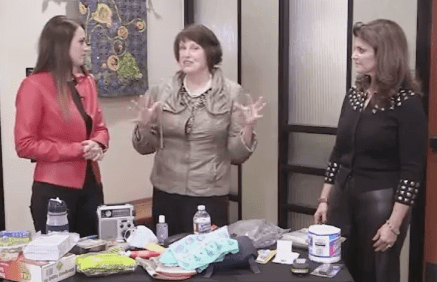By J’Nel Wright, staff writer
Will you be ready when the big one hits? Experts say that earthquake forecasts show that the likelihood of a moderate earthquake – between magnitude 6.5 and 7.5 – has decreased, but the chance of a higher-magnitude quake in the region has increased.
“We are locked, loaded, and ready to roll for another earthquake happening,” says Glenna Anderson, an expert in disaster preparedness. “Scientists say there is 99 percent chance of an earthquake in Orange County within the next 30 years.” So what can we do to better prepare ourselves when disaster strikes? Anderson shared some of her favorite tips.
Look at your environment.
Having experienced an earthquake during a stay in Mexico, Anderson discovered some little adjustments that can make a huge difference when navigating after an earthquake, especially the amount of debris.
Pack extra shoes.
Between broken glass, damaged structures, busted water lines, and other hazards, an earthquake generates a large amount of debris. Glenna keeps a pair of shoes by her bed, and she stores a pair in her car, so she is always prepared with comfortable and sturdy shoes.
Take note of high shelves and wall hangings.
Look at things hanging on the walls or sitting on high shelves. Are there paintings or heavy objects that can fall and potentially hurt you?
Know the best location in an emergency.
True or false? Standing in the doorway is the safest place to withstand an earthquake. The answer is, FALSE! “Drop, Cover, and Hold on,” says the Earthquake Country Alliance group.
Drop to your hands and knees prevents you from getting knocked over.
Cover your head and neck with one arm and hand. Don’t crawl under a bed or furniture that will make it difficult for rescuers to find you. Crouching beside a bed or couch means debris will likely hit the higher-positioned furniture rather than hitting you.
Hold on and be ready to move WITH your shelter if it shifts.
Prepare a 72-hour kit.
Depending on where you live, you may not have access to power, clean water, food, or emergency services for an extended time. It’s important that you are prepared to keep your family safe until help arrives. Also, you may not be able to remain in your home, so having supplies in a local area where you canquickly grab it and go is important. Prepare needed supplies and place in a backpack or a waterproof bucket that is easy to take with you in an emergency.
Remember: your routine won’t change due to a natural disaster. For example, be sure to pack medications or medical supplies that you need every day. Also pack things like contact lens cleaner, extra eyeglasses, toilet paper, first-aid kit, matches, flashlights and extra batteries, paper and pencils, and phone numbers. Be sure each member of your family has a backpack filled with clothing, blanket, toys, baby formula (if needed), and enough food and water to sustain each family member for three days. Don’t forget your pets. Be sure to pack extra food for your furry friends.
Don’t forget the water.
We know that water is one of the most essential items in an emergency, but how much is enough? The Centers for Disease Control and Prevention says each family member needs one gallon of water per day. And don’t forget your pets! Your animals need one gallon of water each day, too.
If you would like more information on how to better prepare you and your family for a natural disaster, Glenna can help! You can email her at glenna8@cox.net.

